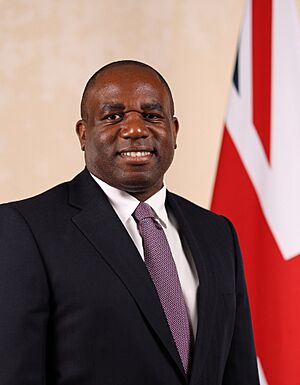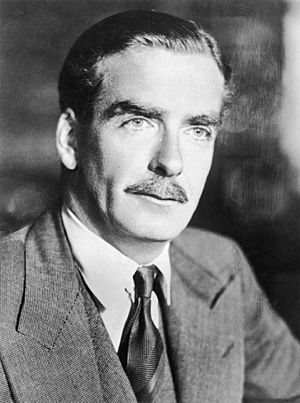Deputy Prime Minister of the United Kingdom facts for kids
Quick facts for kids United KingdomDeputy Prime Minister of the United Kingdom of Great Britain and Northern Ireland |
|
|---|---|
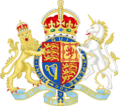
Royal arms of His Majesty's Government
|
|
| Government of the United Kingdom Cabinet Office |
|
| Style |
|
| Member of |
|
| Reports to | The Prime Minister |
| Residence | None, may use grace and favour residences |
| Seat | Westminster |
| Formation | 1942 |
| First holder | Clement Attlee |
The Deputy Prime Minister of the United Kingdom is a special title given to a very important minister in the British government. This person is a member of the British Cabinet, which is a group of senior ministers who make big decisions. The title usually goes to a senior minister, the second-in-command of the ruling political party, or a close friend and helper of the Prime Minister.
This role doesn't come with its own set of laws or rules. Instead, the Prime Minister gives the Deputy Prime Minister specific jobs to do. Lately, this has often meant standing in for the Prime Minister in the House of Commons, both in the UK and when traveling to other countries. The Deputy Prime Minister often also holds another important job, like being a secretary of state for a government department. Sometimes, the title isn't used at all, or a Prime Minister might choose someone as a 'First Secretary of State' or just an informal helper.
The current Deputy Prime Minister is David Lammy. He has been serving under Sir Keir Starmer since 5 September 2025. Mr. Lammy took over from Angela Rayner after she resigned from her position.
Contents
- What is the Constitutional Position of the Deputy Prime Minister?
- What are the Responsibilities of the Deputy Prime Minister?
- A Brief History of the Deputy Prime Minister Role
- Office and Residence
- List of Deputy Prime Ministers
- Timeline of Deputy Prime Ministers
- Unofficial Deputies
- What Happens if the Prime Minister Cannot Serve?
- See also
What is the Constitutional Position of the Deputy Prime Minister?
The title of Deputy Prime Minister is more of an honorary title. For a long time, the King or Queen didn't officially recognize it. The person holding this title doesn't get an extra salary just for being Deputy Prime Minister. Also, if the Prime Minister were to leave office, the Deputy Prime Minister doesn't automatically become the new Prime Minister.
For example, in 1942, when Winston Churchill wanted to make Anthony Eden his Deputy Prime Minister, King George VI said that such a job 'does not exist'. The King worried that giving someone this title might look like he was being told who the next Prime Minister should be, which would limit his own power to choose. However, experts like Vernon Bogdanor say that today, the King or Queen doesn't really choose the Prime Minister anymore, so this old argument isn't as important.
What are the Responsibilities of the Deputy Prime Minister?
The jobs of the Deputy Prime Minister can change depending on the situation. As of late 2024, the Deputy Prime Minister's main jobs included:
- Standing in for the Prime Minister in the House of Commons.
- Representing the Prime Minister both in the UK and when traveling abroad.
- Helping and supporting the Prime Minister with their work.
- Looking after special areas like employment rights and making sure different government departments work together on community issues.
Experts say there are a few reasons why a Prime Minister might choose a deputy. Sometimes it's to show who they think should take over if they can't continue. Other times, it's to help the government run more smoothly. It can also be a way to recognize the importance of the deputy leader of their political party. Some deputies are chosen because they are leaders of another party in a coalition government, or because they are very experienced and reliable.
Having a Deputy Prime Minister (or a First Secretary of State) helps the Prime Minister in two main ways. First, it gives them a trusted helper who can focus on making sure different government departments work well together. Second, it sends a message about how important that person is in the government. This role can also be very helpful if a Prime Minister becomes unable to do their job.
A Brief History of the Deputy Prime Minister Role
Before World War II, there wasn't really a Deputy Prime Minister. If the Prime Minister was sick or away, another minister might step in temporarily. But in 1942, during the war, Winston Churchill gave the title of Deputy Prime Minister to Clement Attlee. This was a special situation because different political parties were working together. The King didn't officially approve the title, but it showed how important the Labour Party was in the government at that time.
After the war, the title wasn't formally used again for a long time, partly because of concerns about the King's role. However, senior ministers often acted as deputies. The title officially returned in 1995 with Michael Heseltine. Because the Deputy Prime Minister title didn't have its own legal powers, Mr. Heseltine was also made First Secretary of State. John Prescott was Deputy Prime Minister for all of Tony Blair's time as Prime Minister, making him the longest-serving one. He also held other important roles, like Secretary of State for different departments.
In 2010, when the Conservative and Liberal Democrat parties formed a coalition government, Nick Clegg became Deputy Prime Minister under David Cameron. He served until 2015. After that, the role was empty for several years during the rest of David Cameron's time and all of Theresa May's time as Prime Minister.
In 2021, Dominic Raab was appointed Deputy Prime Minister under Boris Johnson. He had previously stepped in for Mr. Johnson in 2020 when the Prime Minister was unwell. After Mr. Johnson, Thérèse Coffey briefly held the role in 2022, becoming the shortest-serving Deputy Prime Minister. When Rishi Sunak became Prime Minister, he reappointed Mr. Raab. After Mr. Raab resigned in April 2023, Oliver Dowden took over. Following the 2024 general election, Angela Rayner became Deputy Prime Minister in Keir Starmer's government. She was then succeeded by David Lammy on 5 September 2025.
Office and Residence
There isn't a specific office always set aside for the Deputy Prime Minister. Deputy Prime Minister Nick Clegg had an office at the Cabinet Office headquarters, 70 Whitehall, which is connected to 10 Downing Street. His predecessor, John Prescott, used an office at 26 Whitehall.
The Prime Minister might also let the Deputy Prime Minister use a special country house, known as a grace and favour residence. While in office, Nick Clegg lived in his own home and shared Chevening House as a weekend residence with William Hague, who was the First Secretary of State. John Prescott used Dorneywood.
List of Deputy Prime Ministers
The following people have officially held the title of Deputy Prime Minister.
| Deputy Prime Minister | Term of office | Duration | Other ministerial portfolios held during tenure | Party | Ministry | |||
|---|---|---|---|---|---|---|---|---|
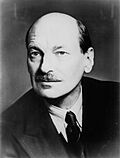 |
Clement Attlee MP for Limehouse (1883–1967) |
19 February 1942 |
23 May 1945 |
3 years, 94 days |
|
Labour | Churchill War | |
| Office vacant | 23 May 1945 |
5 July 1995 |
50 years, 44 days | |||||
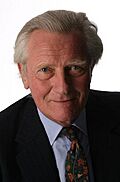 |
Michael Heseltine MP for Henley (born 1933) |
5 July 1995 |
2 May 1997 |
1 year, 302 days | Conservative | Major II | ||
 |
John Prescott MP for Kingston upon Hull East (1938–2024) |
2 May 1997 |
27 June 2007 |
10 years, 57 days |
|
Labour | Blair I | |
| Blair II | ||||||||
| Blair III | ||||||||
| Office vacant | 27 June 2007 |
11 May 2010 |
2 years, 319 days | |||||
 |
Nick Clegg MP for Sheffield Hallam (born 1967) |
11 May 2010 |
8 May 2015 |
4 years, 363 days | Liberal Democrat | Cameron–Clegg | ||
| Office vacant | 8 May 2015 |
15 September 2021 |
6 years, 131 days | |||||
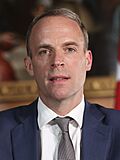 |
Dominic Raab MP for Esher and Walton (born 1974) |
15 September 2021 |
6 September 2022 |
357 days |
|
Conservative | Johnson II | |
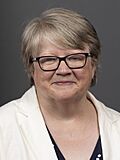 |
Thérèse Coffey MP for Suffolk Coastal (born 1971) |
6 September 2022 |
25 October 2022 |
50 days | Truss | |||
 |
Dominic Raab MP for Esher and Walton (born 1974) |
25 October 2022 |
21 April 2023 |
179 days |
|
Sunak | ||
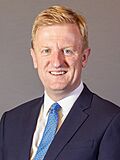 |
Oliver Dowden MP for Hertsmere (born 1978) |
21 April 2023 |
5 July 2024 |
1 year, 76 days |
|
|||
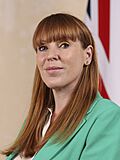 |
Angela Rayner MP for Ashton-under-Lyne (born 1980) |
5 July 2024 |
5 September 2025 |
1 year, 63 days |
|
Labour | Starmer | |
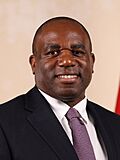 |
David Lammy MP for Tottenham (born 1972) |
5 September 2025 |
Incumbent | 117 days |
|
|||
Timeline of Deputy Prime Ministers

Unofficial Deputies
Sometimes, a Prime Minister's second-in-command might act as a deputy without officially holding the title of Deputy Prime Minister. They might be called a First Secretary of State or simply be seen as the main helper. At other times, Prime Ministers have chosen not to have a permanent deputy at all.
Experts have identified several people who have acted as deputies to the Prime Minister, even if they didn't always have the official title. These individuals often chaired Cabinet meetings when the Prime Minister was away or led important government committees. Some well-known examples include Clement Attlee, Anthony Eden, John Prescott, and Nick Clegg.
What Happens if the Prime Minister Cannot Serve?
No one automatically becomes Prime Minister if the current one cannot continue. However, it is generally agreed that an interim (temporary) Prime Minister would need to be appointed quickly.
In 2021, a senior government official named Simon Case suggested that the Cabinet (the group of senior ministers) would likely choose someone to step into the role. This person would need to be able to lead the government and have the support of the House of Commons. The King or Queen would then be given a clear recommendation very quickly, ideally within 48 hours.
When the Prime Minister travels, a senior minister is usually appointed to handle urgent matters and meetings. However, the Prime Minister remains in charge and stays updated. For example, in April 2020, when Prime Minister Boris Johnson was in hospital, he asked Dominic Raab, who was then First Secretary of State, to act as his deputy when needed.
See also
 In Spanish: Vice primer ministro del Reino Unido para niños
In Spanish: Vice primer ministro del Reino Unido para niños
- First Secretary of State
- Deputy Leader of the Labour Party (UK)


